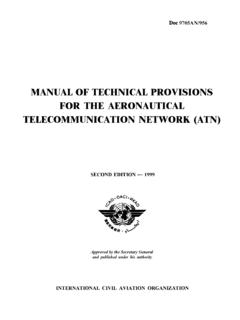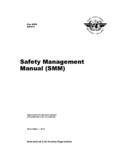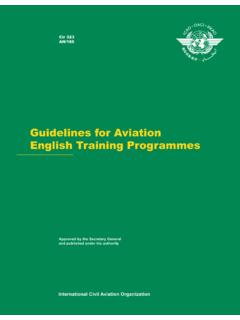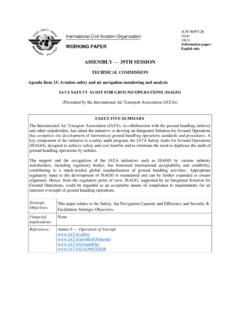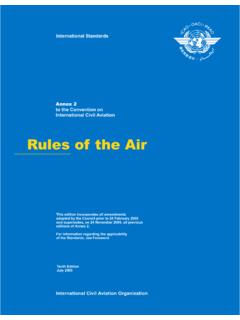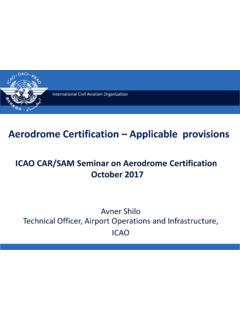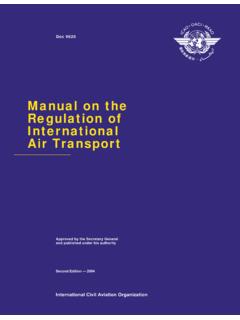Transcription of Water Management at Airports - ICAO
1 Water Management at AirportsECO AIRPORT TOOLKITENVIRONMENTW ater Management at Airports Foreword Water resources are under increasing pressure due to growing demand, urbanisation and climate change. Some regions of the world are facing Water scarcity and these situations are likely to multiply in the future. In addition, competition between various Water uses is increasing as demand intensifies, potentially leading to Airports need to consider Water in three primary ways. The first is supply, the Water entering the airport facility and whether there are ways that the airport can reduce its demand for Water . Secondly, handling capacity, Airports experience Water events such as flooding, drainage issues, erosion and other impacts. Thirdly, disposal, Airports need to ensure Water leaving the airport facility is clean and is safe for the surrounding environment.
2 Airport systems manage these processes in various ways. Supply: Airports rely on the local availability of Water for their own activities. They are also indirectly affected by the regional Water situation. When the levels of Water stress2 are too high, the activities of the whole region may be compromised. In the Middle East, for example, cities are increasingly reliant on costly seawater desalinisation infrastructure for their drinking Water supply. Airports are encouraged to put in place responsible Water consumption policies as well as Water efficiency measures. Simple technologies like aerators, low-flush toilets and rainwater capture systems can significantly reduce overall Water Handling Capacity: Managing stormwater quality and quantity are especially challenging tasks for Airports .
3 To address Water issues, Airports can work closely with local Water stakeholders and adopt an Integrated Water Resources Management (IWRM)5 approach. Airports need to examine future climate predictions and design runoff systems to handle predicted rainfall events. This will help the airport avoid flooding events and will also reduce pollution reaching nearby waters. Specific stormwater Management plans should be developed, as well as flood contingency plans for locations susceptible to flooding. Particular attention must be paid to the maintenance of Water networks and the detection of leaks, which in some regions has resulted in Water losses of up to 50%. Climate change will also affect the Water levels, especially near coastlines. In addition, Airports will increasingly experience more adverse climate change induced effects specifically associated with increasing precipitation intensities, sea level rise and storm surge.
4 Coastal Airports need to consider 1 See UN Water documentation. 2 According to the United Nations Environment Program (UNEP), Water stress occurs when the demand for Water exceeds the available amount during a certain period or when poor quality restricts its use, causing deterioration of fresh Water in terms of quantity. 3 In UN City Copenhagen, the building s overall Water use decreased by over 60%. 4 At Paris Charles De Gaulle Airport, more than 72,600 cubic meters of rainwater is collected per year, equivalent of 5% of its annual consumption of drinking Water , and generating an annual saving of around 150 k . 5 See UNESCO report - Integrated Water resources Management in action. :/48223/pf0000181891 2future tidal elevations and seawall protection measures when replacing old or designing new infrastructure.
5 This can also be a factor near rivers which can rise above historical flood level if intense storms release heavy amounts of rainfall upstream. ICAO discusses these concerns in the recently released Climate Adaptation Synthesis Report and associated fact Disposal: Water quality is essential to human health, food security and economic development, and many National and local governments have policies and/or regulations regarding Water Management and pollution prevention . pollution from the airport has the potential to affect not only the immediate area, but also the surrounding Water quality is often classified by its use, using the terms wastewater, grey Water , and black Water . Wastewater generally refers to any Water that has been subjected to a human use, whether domestic or industrial.
6 Grey Water is the term for relatively clean wastewater from baths, sinks, laundry facilities and other Grey Water can sometimes be collected and used in other applications, such as landscape irrigation. Black Water contains sewage, or Water from toilets. Black Water must be treated in municipal treatment facilities. Some wastewaters are so polluted with industrial substances as to require special handling, treatment, and disposal methods, while some wastewaters, after treatment, can be discharged back into local Water sources. Airports have focused on methods to decrease the pollutant level in airport Water . Areas of concern are the amount of de-icers and anti-icers used on runway surfaces and aircraft. Limiting the amount of pollutants used on airport is a major focus in reducing the amount of treatment and facilities devoted to treatment that need to take place.
7 Proper storage and handling of pollutants is key to preventing spills, and Airports are also isolating the pollutants that they use from non-polluted Water flowing on the airport to avoid contamination. All these measures will help reduce the cost of Water for an airport, reduce environmental impacts, and improve resilience to risks associated with Water shortages, floods, and climate hazards. Airports can also participate in innovative initiatives such as projects focusing on the re-use of treated wastewater for agriculture These actions will help to collectively decrease the demand for clean Water . In hot regions, such projects can also help reduce the local air temperature at Airports , thus decreasing energy needs for cooling systems and improving resilience to heat Water Conservation and Green Infrastructure In some areas of the world, Water is a finite resource and Water uses must be carefully considered.
8 When planning and designing new airport structures considering the Water resources of the area is 6 #:~:text=The%20 International%20 Civil%20 Aviation%20 Organization,information%20on%20those%20 potential%20risks. 7 ICAO Airport Planning Manual Part 2, Section 8 From Oxford s Lexico: 9 See FAO - Exploring the use of wastewater in agriculture. 10 The Adelaide Airport heat reduction trial. 3essential. Water Management is easiest if considerations are made early on in airfield design and development. Avoiding impacts to geographic Water features, including underground aquifers, are recommended practice along with avoiding sites prone to flooding. Some elements to consider during the planning and design phase are changing flood frequencies, rising sea levels, and ensuring that construction of the facility does not negatively impact the watershed within the surrounding area.
9 In addition, numerous actions can be taken to reduce the consumption of potable Water at a facility including installation of low flow toilets, or utilizing rainwater collected from roofs. Graywater from the airport may be useful for other activities, such as irrigation of landscaping. Such practices to reduce Water use help extend the availability of Water resources in the region and lowers demand on local Water utility providers. Water infrastructure like drains, culverts and catch basins should be designed for adequate capacity, and kept clear and functioning. Some Airports have systems that monitor Water flow and sound alarms when peak capacity is reached or a pipe is blocked. When developing new facilities, the use of smart building and design practices helps Airports minimize their Water consumption.
10 The certification systems for green building designs and sustainable infrastructure such as ISO 14001 standards, Boma Go Green, BREEAM, LEED, or ENVISION all consider issues of Water use and conservation within their rating For more information on the Eco-designing of Airport Buildings, see the Eco-Airport Toolkit dedicated publication and case Water Sensitive Airports Airports play a vital role in economic growth and are essential hubs for connectivity and trade. The locations of major Airports can be vulnerable to Water extremes, which have been intensifying due to the effects of climate change. Planning for resiliency is critical, particularly for those Airports situated in densely populated areas next to rivers, in deltas or in coastal areas. Implementing good stormwater practices early on can help build climate resilience for the future.


